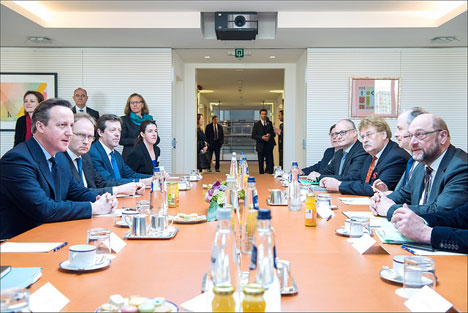The UK’s decision to hold an in-out referendum on EU membership is a momentous one. It is a major fork in the road that could reshape the map of Europe. The ambiguity of Britain’s relationship with the European Union is not new. Even when the UK was “out” (1950-73) it did not want to be completely “out”. Even since it has been “in” (1973-now), it has never been completely “in” such processes as monetary union.

Discussing the reform of the UK’s EU membership in February 2016: David Cameron meeting Martin Schulz and the MEPs Guy Verhofstadt, Roberto Gualtieri and Elmar Brok. Photo: European Union 2016 – European Parliament. Source:Flickr
Yet for a long time there was at least a stable core of agreement in the UK that it should – one way or another – retain access to the EU’s single market. Now even that has been put into question by those advocates of Brexit who argue the UK should be prepared to settle for a looser free trade agreement, rather than accept the regulation and “loss of sovereignty” implied by continued participation as a non-member state in the single market.
Forms of EU association
It is easy to forget that the EU has been quite responsive to the UK’s ambivalence, in permitting both opt-outs and opt-ins. EU internal differentiation is also reflected in the EU’s associations with non-members, which range from the European Neighbourhood Policy (ENP), to Turkey’s customs union, to Switzerland’s bilateral approach and to the multilateral European Economic Area agreement (EEA) for Norway, Iceland and Lichtenstein.
These forms of association are not only different degrees of institutionalization; they also offer different degrees of market access and “market citizenship”. There are different degrees of legal certainty and protection. An important observation here is that, given the EU’s internal pressures (demands for special status and opt outs), it is trying to reduce the range of forms of external association, not least to protect the internal coherence of the Union.
The problem of hegemony
The main finding of our recent book The European Union’s Non-members: Independence Under Hegemony? (2015) is that non-EU states – whether affiliated through sectoral bilateral agreements in the case of Switzerland or multilateral dynamic agreements in the cases of Iceland and Norway – are more and more closely tied to a constantly changing and integrating entity over which they have no formal say. They relinquish sovereignty in a way that is not recompensed by co-determination. This has two important implications with direct relevance to the UK debate. The first is that even if non-members such as Norway and Switzerland have established different formal arrangements with the EU, the effects are nevertheless remarkably similar. The other implication is that the EU’s closely associated non-members are subject to a form of self-inflicted hegemony. Interestingly, the closer and more formalized the association, the more manifest this problem becomes.
A hegemon wields power over other subordinate states. It dominates by interfering in zones of autonomy and by limiting the subordinates’ sovereignty. There is a profound irony in applying this notion to the European Union: after all, the integration process was initiated with a view to abolishing political rivalry and hegemony in Europe by granting the states equal membership in the fledgling European political order. The EU dominates those associated states from outside neither intentionally nor by deception nor by manipulation. It is hegemony by default: by rejecting EU membership, these states have become subject to hegemonic dominance. These states have unintentionally turned the EU into a hegemon vis-à-vis themselves.
Norway as a rule-taker
Take Norway as an example: in 1994, the most important argument against EU membership concerned the right to self-determination, popular rule and democracy. But every government since then has brought Norway closer to the EU, and a number of additional parallel agreements have been signed. These include agreements on border controls (the Schengen Agreement), asylum and police cooperation. Norway even puts troops at the disposal of the EU’s battle groups. Approximately three-quarters of the legislation that applies to the member states applies to Norway. In order to ensure the conformity of the internal market, the same rules apply to the EEA partners as to the EU countries (the homogeneity principle). New agreements have been established over time, and existing agreements have been developed and expanded. The cumulative effects are far reaching but not well understood.
The sheer volume of agreements, and the establishment of new EU authorities and agencies to which Norway cedes sovereignty, have severe implications for national independence and democracy. Norway has relinquished sovereignty in a number of areas through regular majority voting by EU member states; it pays (through the EEA financial contributions) for access to the single market, and is often subject to EU law on the same basis as the EU’s member states. Norway has surrendered sovereignty without receiving in return any of the co-determination that EU membership would have granted. The slogan “no taxation without representation” from the US War of Independence does not apply here.
If then the EU is not in itself structured as a hegemon in relation to its member states, in what specific sense is its relationship with the associated states a matter of hegemony?
Implications for the UK debate
It appears to us that this question has direct bearings on the UK debate, which needs to focus more closely on precisely the factors that make the relationship between the EU and associated states one of hegemony. One obvious factor is that the relationship is a highly lopsided or asymmetrical power relationship, where one side is far more dependent on the other than vice versa. The bargaining power of Norway and Iceland is weak. For the UK the question is whether its size and strength can be brought to bear in this respect.
A second factor is that hegemony is in a deeper sense institutionalized. One aspect is that the EU reconfigures state sovereignty by placing a stronger accent on co-determination. The EU deals with any need to constrain participating states by offering them the opportunity to participate in co-determining policies in exchange for constraints on their individual sovereignty. However, if countries, for whatever reason, end up adopting EU policies without being full members of the EU, they may experience a loss of autonomy without any prospect of participating in the Union’s processes of co-determination through shared decision-making.
Since the emphasis on co-determination clearly also relates to constitutional questions, the lack of access to such bodies as the European Council also entails a lack of influence on the processes that determine the associated state’s scope for and terms of self-determination. The structure of the association is such that the closer the association, the more the EU determines the conditions for democratic self-rule in associated non-member states.
Third, the EEA Agreement is a dynamic framework agreement that does not need to be renegotiated whenever the EU adopts a new regulation. The Agreement is continually updated so that the laws and regulations remain consistent throughout the EEA. This dynamic aspect is important for the realization of the basic intention: the maintenance of a homogeneous market throughout the whole area. Even the Swiss relationship is far more dynamic in practice than its formal bilateral arrangements would suggest.
Non-members, to a much higher degree than members, experience new EU treaties or reforms as “shocks” for which they are but poorly prepared, given their lack of access to the EU. This adds a great measure of uncertainty to the dynamism: non-members must come to terms with the fact that their ability to foresee or predict such shocks is very low. From the point of view of the associated members, barred as they are from co-determining the Union’s course, enlargements increase asymmetry and also arbitrariness.
The cost of exit
European states that are heavily involved in the European economy but have chosen not to become EU members are faced with the choice of legal certainty (EEA membership) or arbitrariness. The former entails hegemonic submission. The latter however does not imply independence but arbitrary dominance due to the high degree of interdependence.
For any of the associated non-members, the cost of exit is high because there is a very high degree of connectivity; the general feeling is that uncertainty is greater without an agreement; the EU reaches into almost all policy fields where member states are concerned, and these horizontal dynamics are also important both in the Nordic region and for Switzerland; the EEA arrangement is not merely an international contract regulating a specific area of common interest.
What is peculiar about the form of dominance that the associated non-members experience is that it is both structural and at the same time voluntary. It is an arrangement that accidentally inhibits and intimidates the parties. The management of externalities and problems of collective action created by interdependence is skewed by the European political order in favour of full members of the EU. By being excluded from co-decision-making procedures, the citizens of the associated states have the status of second-rate Europeans.
Precisely the question of second-rate status takes on added importance at a time of crisis-induced transformation in Europe. The crisis leads to more uncertainty and unpredictability; thus increased dominance. How the EU grapples over time with the fallout of the crisis will therefore be fundamentally important also for the associated states, as well as for a potential Brexit.







